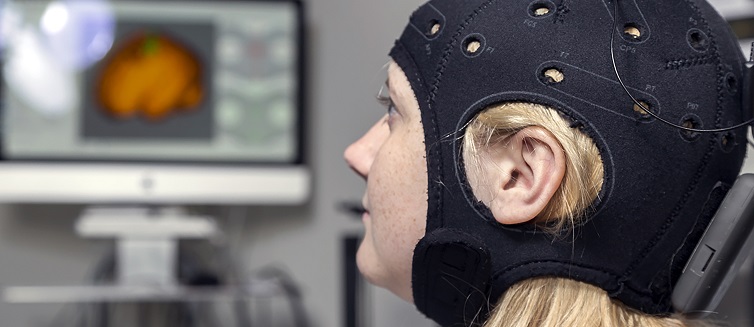It has helped ski jumpers jump farther, cyclists pedal faster, and weight lifters lift heavier weights. It’s perfectly safe. And someday soon, if promising research at the University of Pittsburgh, UPMC and other institutions is successful, it may be used in rehabilitation centers around the country to help stroke survivors recover more strength and dexterity.
Never Miss a Beat!
Subscribe to Our HealthBeat Newsletter!
Thank you for subscribing!
You can now select the specific newsletters you'd like to receive.
You are already subscribed.
Subscribe to more newsletters in our email preference center.
Sorry, an error occurred. Please try again later.
Get Healthy Tips Sent to Your Phone!
Stimulating but Non-Invasive
This new performance enhancer is called non-invasive brain stimulation (NIBS). It’s a way of waking up brain cells through electrical or electromagnetic stimulation and boosting their ability to learn new skills. For athletes, this means coaxing more performance out of muscles that are already performing at a high level. For stroke survivors, it can mean bringing inactive muscles back to life.
“Opening a fridge door, using a hair dryer; they seem like small things that we all take for granted,” says UPMC’s Amit Sethi, PhD, OTR/L, assistant professor at The University of Pittsburgh. “But if you’ve had a stroke and you can’t move your hand, you’re looking at a big disability.”
Since weakness in one hand is a common effect of stroke, appearing in about 85 percent of patients, Dr. Sethi and his team are focusing on hand rehabilitation in their ongoing study of the feasibility and efficacy of NIBS at UPMC’s Rehabilitation Institute in Pittsburgh, Pennsylvania.
Jump-Starting Neuroplasticity
Dr. Sethi’s program blind-tests NIBS on two groups of chronic stroke patients who have passed the six-month window for recovery through conventional stroke therapy. One group is treated with occupational therapy and the other gets occupational therapy plus accompanying NIBS treatment. The NIBS is delivered in the form of externally applied electrical or electromagnetic pulse, targeted at the stroke-impaired area of the brain. “We’re working with the brain’s neuroplasticity—that is the brain’s ability to retrain nearby nerve cells to take over the function that injured nerve cells can no longer do,” says Dr. Sethi.
Why test NIBS on chronic patients as opposed to those who have just had a stroke? “We’re testing after the six-month window so that we can isolate the effect of NIBS on recovery,” he explains. “Theoretically, the brain’s own healing process is over after six months, and these patients typically have little chance of getting better. So if hand function improves, it’s because of NIBS, not the brain’s own healing process.”
Promising Results for Stroke Patients
So far, the patients are, in fact, getting better in both groups. More than halfway into the study, co-sponsored by UPMC, the University of Pittsburgh and the National Institutes of Health, more than 90% of the patients are showing significant results. “Some of them are improving more than others, as much as twice what we’d see in other studies,” adds Dr. Sethi. Theoretically, these overachievers will correlate with the NIBS treatments, a hypothesis that will be evaluated when the study finishes next year.
It has helped ski jumpers jump farther, cyclists pedal faster, and weight lifters lift heavier weights. It’s perfectly safe. And someday soon, if promising research at the University of Pittsburgh, UPMC and other institutions is successful, it may be used in rehabilitation centers around the country to help stroke survivors recover more strength and dexterity.
It’s All About Synergy
Currently, 800,000 people in America suffer a stroke every year, a rate that’s on the rise as our population ages. Rehabilitation therapy and techniques for improving its effectiveness are gaining importance as experts consider the future of healthcare. Dr. Sethi is looking to continue his research and work with the UPMC Rehabilitation Institute at UPMC’s new Vision and Rehabilitation Hospital in Pittsburgh, to be completed in 2020. The new multimillion dollar facility will serve one of the largest rehabilitation networks in the U.S., treating nearly 5,000 inpatients and more than 70,000 outpatients a year, and its impact on research will be significant.
“It’s more than just operating in a state-of-the-art facility,” says Dr. Sethi. “We’ll have better access to patients and a great opportunity to synergistically collaborate with the therapists to influence change.” And with rehab, that’s what it’s all about.”
About UPMC Rehabilitation Institute
The UPMC Rehabilitation Institute offers inpatient, outpatient, and transitional rehabilitation, as well as outpatient physician services so that care is available to meet the needs of our patients at each phase of the recovery process. Renowned physiatrists from the University of Pittsburgh Department of Physical Medicine and Rehabilitation, as well as highly trained physical, occupational, and speech therapists, provide individualized care in 12 inpatient units within acute care hospitals and over 80 outpatient locations close to home and work.
